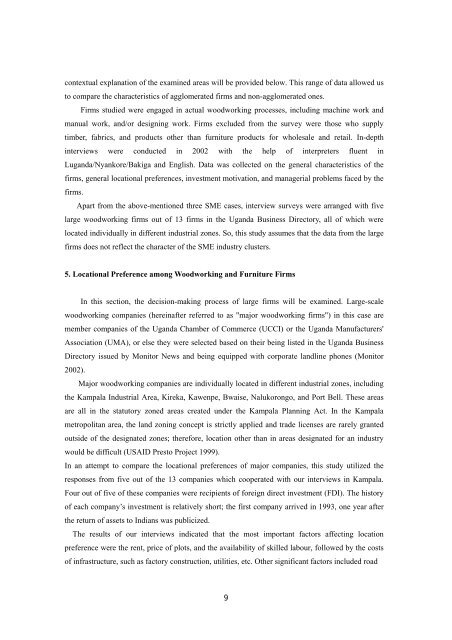Information - ARRIDE - IDE-JETRO
Information - ARRIDE - IDE-JETRO
Information - ARRIDE - IDE-JETRO
You also want an ePaper? Increase the reach of your titles
YUMPU automatically turns print PDFs into web optimized ePapers that Google loves.
contextual explanation of the examined areas will be provided below. This range of data allowed us<br />
to compare the characteristics of agglomerated firms and non-agglomerated ones.<br />
Firms studied were engaged in actual woodworking processes, including machine work and<br />
manual work, and/or designing work. Firms excluded from the survey were those who supply<br />
timber, fabrics, and products other than furniture products for wholesale and retail. In-depth<br />
interviews were conducted in 2002 with the help of interpreters fluent in<br />
Luganda/Nyankore/Bakiga and English. Data was collected on the general characteristics of the<br />
firms, general locational preferences, investment motivation, and managerial problems faced by the<br />
firms.<br />
Apart from the above-mentioned three SME cases, interview surveys were arranged with five<br />
large woodworking firms out of 13 firms in the Uganda Business Directory, all of which were<br />
located individually in different industrial zones. So, this study assumes that the data from the large<br />
firms does not reflect the character of the SME industry clusters.<br />
5. Locational Preference among Woodworking and Furniture Firms<br />
In this section, the decision-making process of large firms will be examined. Large-scale<br />
woodworking companies (hereinafter referred to as "major woodworking firms") in this case are<br />
member companies of the Uganda Chamber of Commerce (UCCI) or the Uganda Manufacturers'<br />
Association (UMA), or else they were selected based on their being listed in the Uganda Business<br />
Directory issued by Monitor News and being equipped with corporate landline phones (Monitor<br />
2002).<br />
Major woodworking companies are individually located in different industrial zones, including<br />
the Kampala Industrial Area, Kireka, Kawenpe, Bwaise, Nalukorongo, and Port Bell. These areas<br />
are all in the statutory zoned areas created under the Kampala Planning Act. In the Kampala<br />
metropolitan area, the land zoning concept is strictly applied and trade licenses are rarely granted<br />
outside of the designated zones; therefore, location other than in areas designated for an industry<br />
would be difficult (USAID Presto Project 1999).<br />
In an attempt to compare the locational preferences of major companies, this study utilized the<br />
responses from five out of the 13 companies which cooperated with our interviews in Kampala.<br />
Four out of five of these companies were recipients of foreign direct investment (FDI). The history<br />
of each company’s investment is relatively short; the first company arrived in 1993, one year after<br />
the return of assets to Indians was publicized.<br />
The results of our interviews indicated that the most important factors affecting location<br />
preference were the rent, price of plots, and the availability of skilled labour, followed by the costs<br />
of infrastructure, such as factory construction, utilities, etc. Other significant factors included road<br />
9




![Title [書評] 廣田義人著『東アジア工作機械工業の技術形成 ... - ARRIDE](https://img.yumpu.com/47139953/1/184x260/title-arride.jpg?quality=85)






